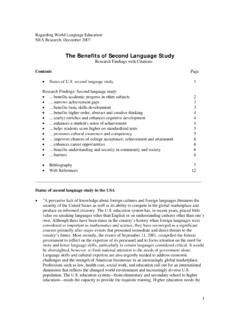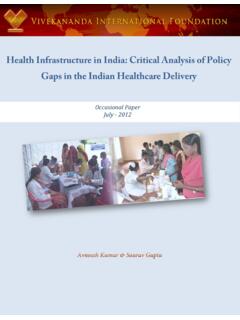Transcription of Brazil - OECD
1 OECD 2019 Education at a Glance: OECD Indicators (OECD, 2019[1]) is the authoritative source for information on the state of education around the world. It provides data on the structure, finances and performance of education systems in the 36 OECD countries and a number of partner countries. Brazil About 33% of students who enter a bachelor s programme in Brazil graduate within the programme s theoretical duration, below the average of 39% for countries with available data. The completion rate after three additional years increases to 50%, still below the average of 67%. Young women in Brazil are 42% more likely to have attained tertiary education than men, although they are less likely to be employed. Although Brazil spends an above-average percentage of its gross domestic product (GDP) on education, spending per student on primary to upper secondary levels is well below the OECD average.
2 Enrolment of children under the age of three in early childhood education has increased considerably, from 10% in 2012 to 23% in 2017, although it remains below the OECD average of 36%. Average teachers salaries in Brazil are lower than in most OECD countries in purchasing power parity terms, and at least 13% lower than the average earnings of tertiary-educated workers in the country. Figure 1 . Completion rate of full-time students who entered a bachelor's or equivalent programme (2017) Note: For countries with true cohort data, the completion includes students who transferred and graduated from another tertiary level. 1. Year of reference differs from 2017. Refer to the source table for details. 2. Completion rate of students who entered a bachelor's programme does not include students who transferred and graduated from short-cycle programmes.
3 3. The theoretical duration plus 3 years refers to the theoretical duration plus 2 years. 4. Data do not include entrants to 6-year bachelor's programmes, which correspond to about 2% of total entrants at this level. 5. Data refer only to the hautes coles (HE) and the coles des arts (ESA), representing about 60% of entrants to bachelor's or equivalent programmes. 6. Data refer to estimated completion rates based on a modelled relationship between future graduates and students still enrolled. Countries and economies are ranked in descending order of completion rate by theoretical duration (true cohort) or cross cohort. Source: OECD (2019), Table See Source section for more information and Annex 3 for notes ( ). 2 | OECD 2019 Despite expansion in recent years, Brazil s tertiary education sector faces challenges About 18% of adults (25-64 year olds) in Brazil have attained tertiary education.
4 This is similar to the attainment rate in Mexico, but well below other Latin American countries such as Argentina (36%), Chile (25%), Colombia (23%) and Costa Rica (23%). In OECD countries, the average tertiary attainment rate is 39%, over twice that of Brazil . Over the past decade, however, there has been a considerable increase in tertiary attainment among the younger generation (25-34 year-olds), from 11% in 2008 to 21% in 2018. Increasing tertiary attainment requires both increased access and high completion rates both of which are relatively low in Brazil . In 2017, only 15% of 20-29 year-olds were enrolled in tertiary education in Brazil , compared to 22% on average across OECD countries. Moreover, those who enter tertiary education in Brazil are less likely to complete it than in most OECD countries with available data.
5 Only 33% of students who enter a bachelor s programme in Brazil graduate within its theoretical duration (4 or 5 years, depending on the programme), compared to an average of 39% among countries with available data (Figure 1). After three additional years, the completion rate increases to 50%, still below the average of 67%. Of the remaining students who have not graduated within this timeframe, about one-third are still enrolled in tertiary education and two-thirds have left the system without graduating. Those who do attain tertiary education in Brazil tend to graduate from a bachelor s programme, and very few pursue a master s or doctoral degree, although bachelor s degrees in Brazil tend to be longer than their equivalents in Europe or North America. Only of 25-64 year-olds in Brazil have attained a master s degree, well below all OECD countries and the OECD average of 13%.
6 Only about have attained a doctorate, just over one-fifth the OECD average of Over three-quarters of bachelor s students in Brazil attend private universities, in stark contrast to most OECD countries, where this is the case for less than one-third of students. It also stands in contrast to all other levels of education in Brazil : over 80% of primary to upper secondary students attend public institutions. Brazilian public universities are free of charge, whereas private universities charge a wide range of tuition fees. The dominance of fee-paying private provision, and the limited number of places in free public institutions, creates a complex environment for policy makers seeking to ensure that access to tertiary education is not hindered by students socio-economic status. Public tertiary institutions tend to have more teaching resources than private ones.
7 In 2017, there were 42 students per teaching staff member in private tertiary institutions the highest ratio among all OECD and partner countries and over times the OECD average of 16. Meanwhile, there were only 11 students per teaching staff in public institutions, one of the lowest ratios across OECD countries and below the OECD average of 15. This difference may be at least partially explained by the fact that public universities in Brazil undertake most of the research in the country, thus requiring more academic staff (Clarivate Analytics, 2018[2]). Over 80% of master s and doctoral students in the country are enrolled in public institutions, and these programmes naturally have a low ratio of students to teaching staff. Public spending in public tertiary institutions increased by 19% between 2010 and 2016.
8 Nevertheless, spending per student in public institutions in Brazil was still below average in 2016, at USD 14 200,1 compared to the OECD average of USD 16 100. Direct spending on public institutions represented about of the country s GDP in 2016, slightly above the OECD average of , and 16% higher than in 2010 (Figure 2). When public spending outside education institutions, such as transfers to households, is also included, tertiary education accounts for of GDP, again above the OECD average of As in most OECD countries, the most common broad field of study at tertiary level in Brazil is business, administration and law, which accounts for 33% of recent graduates. The second most popular is education with 20% of graduates, double the OECD average. The distribution of fields of study changes considerably at doctoral level where the most popular field is health and welfare, which accounts for 19% 1 Values reported in equivalent US dollars (USD) have been converted using purchasing power parities (PPPs) for GDP.
9 | 3 OECD 2019 of graduates (OECD average: 17%). This is followed by natural sciences, mathematics and statistics (15%); and engineering, manufacturing and construction (14%). The Brazilian tertiary education system is one of the least internationalised of all OECD and partner countries. Only of tertiary students in Brazil are foreign, compared to the total of 6% mobile or foreign students across OECD countries. Between 2010 and 2017, the share of international or foreign students increased in nearly all OECD countries, but remained stable in Brazil . Moreover, only about of Brazilian tertiary students are enrolled abroad, less than half the OECD total of Figure 2 . Index of change in public expenditure on educational institutions as a percentage of GDP (2010 and 2016) Final source of funds, by level of education, reference year 2010 = 100 1.
10 Primary education includes pre-primary programmes. Countries are ranked in descending order of the index of change in total expenditure on educational institutions as a percentage of GDP. Source: OECD/UIS/Eurostat (2019), Table , available on line. See Source section for more information and Annex 3 for notes ( ). While the gender gap in education increasingly favours women, the situation in the labour market is reversed Women in Brazil (25-64 year-olds) are 34% more likely to have a tertiary education than men. This is one of the widest gender gaps in educational attainment across OECD and partner countries, and it is widening among younger generations. While older women (55-64 year-olds) are 16% more likely to have a tertiary education than men in this age group, the share rises to 42% among 25-34 year-olds.















